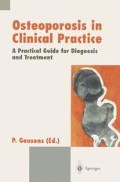Abstract
There is little question that the response of the skeleton to stimuli such as dietary factors and exercise is greatest during periods of rapid growth. Although the precise timing of peak bone mass differs somewhat among the various skeletal sites, by age 18 the skeleton is nearly fully developed and only very modest increases in bone mass or density can be expected after the cessation of longitudinal growth.
Access this chapter
Tax calculation will be finalised at checkout
Purchases are for personal use only
Preview
Unable to display preview. Download preview PDF.
Suggested Reading
Bonjour J-P. (1997) Calcium-enriched foods and bone mass growth. J Clin Invest 99(6):1287–1294.
Crosby LO, Kaplan FS, Pertschuk MJ et al. (1985) The effect of anorexia nervosa on bone morphometry in young women. Clin Orthop 201:271–277.
Drinkwater BL, Breumner B and Chestnut C. (1990) Menstrual history as a determinantof current bone density in athletes. JAMA 263:545–548.
Johnston CC, Miller JZ, Slemenda C et al. (1992) Calcium supplementation and increases in bone mineral density in children. N Engl J Med 327:82–87.
Lloyd T, Andon MB, Rollings N et al. (1993) Calcium supplementation and bone mineraldensity in adolescent girls. JAMA 270:841–844.
Robinson TL, Snow-Harter C, Taaffe DR et al. (1995) Gymnasts exhibit higher bone mass than runners despite similar prevalence of amenorrhea and oligomenorrhea. J Bone Miner Res 10:26–35.
Theintz G, Buchs B, Rizzoli et al. (1992) Longitudinal monitoring of bone massaccumulation in healthy adolescents: evidence for a marked reduction after 16 years of age at the levels of lumbar spine and femoral neck in female subjects. J Clin Endocrinol Metab 75:1060–1065.
Slemenda C, Johnston CC. (1993) High intensity activities in young women: site specificeffects among figure skaters. Bone Miner 20:125–132.
Slemenda C, Reister TK, Hui SL et al. (1994) Influences on skeletal mineralization in children and adolescents: evidence for varying effects of sexual maturation and physical activity. J Pediatr 125:201–207.
Editor information
Editors and Affiliations
Rights and permissions
Copyright information
© 1998 Springer-Verlag London Limited
About this chapter
Cite this chapter
Slemenda, C.W. (1998). Prevention During Growth and Young Adulthood. In: Geusens, P. (eds) Osteoporosis in Clinical Practice. Springer, London. https://doi.org/10.1007/978-1-4471-3382-7_16
Download citation
DOI: https://doi.org/10.1007/978-1-4471-3382-7_16
Publisher Name: Springer, London
Print ISBN: 978-3-540-76223-2
Online ISBN: 978-1-4471-3382-7
eBook Packages: Springer Book Archive

